GE unveils experimental ecoROTR wind turbine
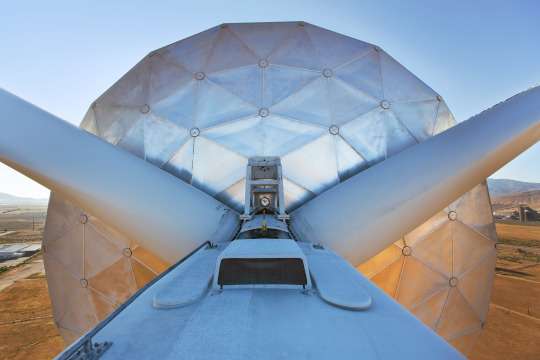
The hillsides around Tehachapi, a brown and blustery town on the edge of California's Mojave Desert, are bristling with a forest of wind turbines of all makes and sizes.
But the tallest and strangest one stands down in the valley. It rises 450 feet from base to blade tips – almost half the height the Eiffel Tower – and has a large spinning silver aluminum dome bolted to its rotor. "It almost looks as if an UFO got stuck on the face," says Mike Bowman, the leader of sustainable energy projects at GE Global Research. "But the dome could be the future of wind."
GE calls the experimental design the ecoROTR and the company started testing it here last month. If the experiments confirm wind tunnel data, the 20,000-pound dome could lead to larger and more efficient turbines for windy locations that are currently too hard to reach for the industry. "As far as I know, there's nothing like this in the world," Bowman says. "This could be a game changer."
The project is part of GE's decade-long ecomagination initiative, focused on building machines with lower environmental impact that save customers money. Specifically, it will tackle two problems with wind turbines: first, they "waste" too much wind and aren't as efficient as they could be. Second, the blades and towers are so big and heavy, they're hard to transport to the remote places where the wind is best.
Styrofoam and toothpicks
The project started with a Styrofoam ball and a toothpick two years ago, when Mark Little, who runs GE Global Research, challenged his scientists to build a rotor that could harvest more wind. "He told the team to look for unexpected answers," Bowman says. "You can't just stretch out the blades. They are already too long and too difficult to ship."
When the team came back, they proposed to give the turbine a big flat nose. "The design looked really strange, but it made a lot of sense," Bowman says. "When wind hits the center of the wind turbine where the blades are attached, it's wasted. That's because the blades are basically levers and the same wind generates more force further from the hub."
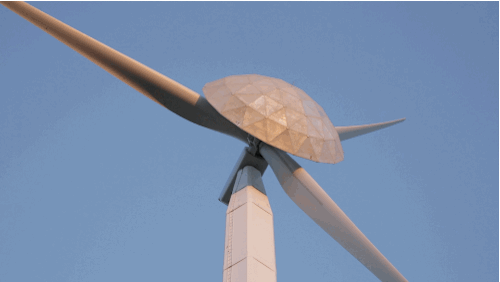
Bowman's team thought that if they deflected the wasted wind from the hub, the blade tips could harvest its power. The nose could also allow them to build bigger rotors without lengthening the blades, since they could attach them to its perimeter.
The group decided to test the idea in a wind tunnel at GE's lab in upstate New York. They sliced a small Styrofoam ball in half and attached it to the front of a small wind turbine model with a toothpick and glue. The team, which included engineers trained in computational flow dynamics, materials scientists, software engineers and other specialists, then ran multiple wind and smoke simulations inside the tunnel.
"When we crunched the numbers, we saw up to a 3 percent increase in performance," Bowman says. "It doesn't seem like much, but it's potentially a lot when you apply the savings across an entire wind farm with dozens of turbines."
From a scale model to 300-foot tower
The next step was to design a life-like ten-foot version of the turbine, which they took to the University of Stuttgart in Germany for more hard-core testing. The team arrived with several different designs and measured their performance, loading and other parameters. The tests gave them clues into what the final product could look like and how it would perform.
Back in the U.S., they used the test results to further validate the design of the full-scale version of the ecoROTR, which is now spinning in Tehachapi.
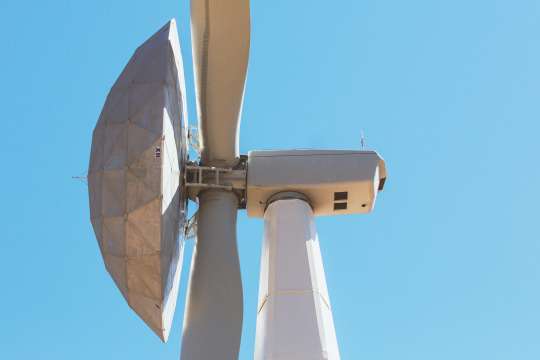
The team attached the experimental dome, which is 60 feet in diameter, to a 1.7-megawatt wind turbine, one of GE's most powerful machines, sitting on top of a 300-foot tower. Like the dome, the tower is also a prototype. Instead of traditional steel tubes, its "space-frame" design uses metal latticework wrapped in a polyester weave coat. The girders can be loaded inside shipping containers and onto ordinary trucks, and bolted together in places that were previously hard to reach.
The view from the top
Bowman has the lean and muscular build of an ultra-marathoner who can handle a 50-kilometer race through New York's Adirondacks wilderness, and he brings the same kind of stamina to his work. Last week, he put on a safety harness and climbed a 300-foot ladder to the top of the turbine for the first time (see below). He inspected the dome and checked large silver Band-Aid-like patches covering a myriad of sensors measuring everything from torque to stress.
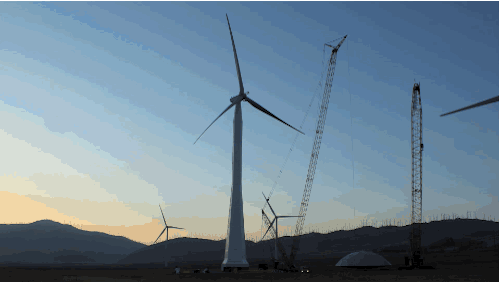
The sensors are everywhere, starting on the tower legs at the ground level, up to the turbine's spinning shaft. The team regularly pores over the data, looking for signs that the experiment is working or needs to be tweaked. This phase of the project will last another four months.
"This is the pinnacle of wind power," Bowman says." I get the feeling ecoROTR and the space-frame tower could be the perfect couple."
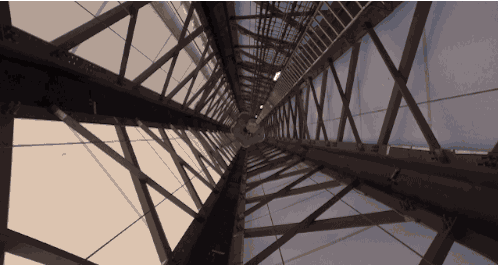
Provided by General Electric



















